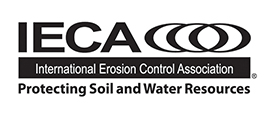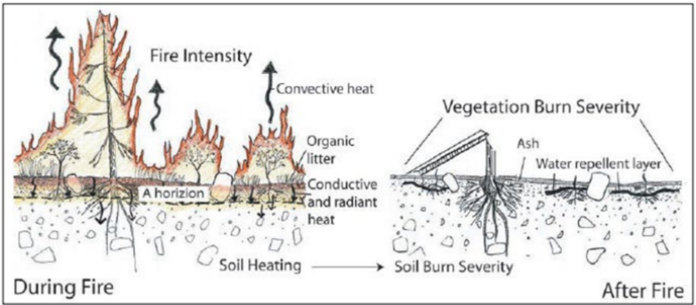Wildfire is a natural phenomenon that can drastically alter watershed hydrologic conditions. Watersheds that experience wildfires can produce peak flows orders of magnitude greater than pre-fire conditions. This is due to several changes in the hydrology of burnt watersheds, especially in the first few years after the wildfire.
Reduced Infiltration
Fires can create water-repellent layers in the soil that reduce the soil’s ability to absorb water. A water-repellent layer left after a fire is termed as hydrophobic, which means soil showing characteristics of water repellency. Hydrophobicity decreases rainfall infiltration and initial rainfall losses and increases direct runoff from a watershed. Through this process, water has a difficult time being absorbed into the soil (Figure 1).1
During the fire, convective heat and burning of the canopy produces organic litter on the forest floor. As the fire intensity increases, the conductive and radiant heat in the soil horizon goes deeper into the ground. This heats up the soil column and creates a water-repellent layer of ash and organic litter. The more intense a fire, the deeper it will burn into the soil column, and the deeper it burns into the soil column, the longer it takes for vegetation to reestablish itself on the canopy floor.
In poor or rocky volcanic soils, extremely hot fires can prevent reestablishment of vegetation for many years. As the erosion continues to wash away the topsoil, reestablishment of a suitable ground canopy becomes very difficult. Initially, ash can enhance infiltration by absorbing rainfall. However, as the ash is washed away, it can clog soil pores, leading to surface sealing and decreased infiltration rates. In particular, the clogging of soil pores, caused by small particles of ash and debris, reduces infiltration across the top layer of the soil, thus facilitating the development of increased surface runoff.2 Fires can also increase soil density and reduce porosity, permanently altering soil texture. This results in decreased water infiltration rates as well as decreased water storage capacity. Lastly, the types of plants and vegetation that grow after a fire may not be similar to the previous existing forest floor, as different plants compete for smaller resources of infiltrated water and stabilized top soil.

Increased Runoff
With the loss of vegetation, there is less interception (e.g., rainfall hitting and staying of tree leaves) of rainfall by plants. This results in more water reaching the ground. Fire-induced water repellency contributes to reduced soil infiltration rates, with stronger effects for higher fire severities. In particular, the clogging of soil pores, caused by small particles of ash, reduces infiltration across the top layer of the soil. With the absence of root structure to break up the top soil horizon and stabilize the slopes, the infiltration capacity continues to reduce.
Soil Erosion
The removal of vegetation and the formation of water-repellent layers can lead to significant soil erosion. This can degrade water quality in streams and rivers by increasing sediment loads. This results in an increase in the soil erodibility factor, or K factor, used in the Revised Universal Soil Loss Equation that is often used to determine watershed annual sediment yield. Overall, there is more energy in the hydrologic system and the increased energy has more capability to transport soil particles necessary to reestablishment of vegetation.
Streamflow Changes
Fires can alter the timing and magnitude of streamflow. After a fire, there may be higher peak flows shortly after rainfall events due to increased runoff caused by decreased infiltration and lower base flows during dry periods because of reduced groundwater recharge. Such effects induce strong responses in watershed hydrology and flood hazards. In-situ measurements carried out in European and North American natural watersheds showed that the annual flood peak in post-fire conditions can increase between 1.2 and 10 times.2 Because there will be less interception from trees and vegetation, there will be less storage in the soil column. Both will cause the runoff to peak sooner than an unburned watershed. Additionally, the forest floor will have less roughness on the ground that increases overland flow wave velocities (Figure 2).3 The time of concentration and lag time decrease which creates a faster peaking flood wave — arriving downstream sooner (Figure 3).

Debris Flows
The combination of increased runoff and soil erosion can lead to debris flows, which are fast-moving landslides that can carry large amounts of sediment, rocks and vegetation downstream. Additionally, the burned canopy and soil horizon increases the amount of sediment loss from a watershed since there are no longer roots and plants to hold the soil column during storm events. Entrainment of soil on hillslopes and in channels bulks up the sediment concentration of the rainfall runoff to generate debris flows capable of transporting boulders and large woody debris. Post-wildfire debris flows can be triggered by frequent and short duration rainfall conditions that would previously produce little runoff during unburned conditions.4
Bulking of Water
Without trees and vegetation holding the soil column, there is an increased sediment loading that is detached first by rainfall impact, and then secondly from increased shear stress over the burned ground. Generally, there is more energy in the system and more sediment and debris available for transport, creating an increase in and “bulking” of flows.5 This means the peak discharge and total water-debris mixture must be increased by a factor determined from references.
Summary
Hydrologic changes due to a watershed wildfire can lead to increased runoff, decreased time of arrival, erosion, bulking of sediment and water flow that impact water quality and watershed health. These results must be considered when designing erosion control measures while rehabilitating burned watershed. A critical consideration when reviewing post fire erosion and sedimentation studies is the Soil Burn Severity. It is also important to know if the study weighted the watershed area as partially being unburned, or if that study included entirely burned area. It is also important to know what methodology was assumed when erosion factors, Curve Numbers or statistical methods were used for post-fire parameter estimates. Results between studies based upon different methodologies can vary by an order of magnitude. In a technical note published by the Natural Resources Conservation Service, there is a notable difference between Appendix A and Appendix B in methodology and values between the High Park and Bitterroot Fires, in addition to Tables 3 through 8.6 This is in part due to the complicated nature of how a wildfire changes the watershed, the geographic location and the methodologies and assumptions for each study.
References
- NRCS, Hydrology Technical Note No. 4, Hydrologic Analysis of Post-Wildfire Conditions, 2016.
- Folador L, Cislaghi A, Vacchiano G, Masseroni D. Integrating Remote and In-Situ Data to Assess the Hydrological Response of a Post-Fire Watershed. Hydrology 2021, 8, 169.
- https://coloradogeologicalsurvey.org/hazards/debris-flows/.
- Gartner J, Kean JW, Rengers FK, McCoy SW, Oakley NS, Sheridan GJ. Post-Wildfire Debris Flows, USGS Publications Warehouse, 2024.
- Elliot WJ, Elliot AV, Qiong W, Laflen JM. 1991. Validation of the WEPP model with rill erosion plot data, paper presented at the 1991 ASAE International Winter Meeting, Am. Soc. Of Agric. Eng., Chicago, IL, Dec. 1991.
- Natural Resources Conservation Service, Hydrology Technical Note No. 4, Hydrologic Analysis of Post-Wildfire Conditions, 2016.
About the Experts:
- David T. Williams, Ph.D., PE, PH, CFM, CPESC, BC.WRE, is president of David T. Williams and Associates, a water resources engineering firm located in the Denver, Colorado, USA area. During his 40 years as a member of IECA, he has served on the board of directors and was president twice.
- Gerald Blackler, Ph.D., PE, BC.WRE, owns and operates Advanced Engineering and Academic Sciences, a Denver, Colorado, USA consulting firm. He is also an instructor at the University of Colorado – Denver College of Engineering, Design and Computing.







